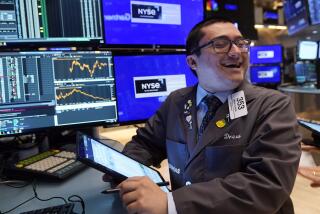‘Little Investors’ Have a Chance to Profit From Plunges, Analysts Say
- Share via
It took longer, but “little investors” who took refuge in over-the-counter and other markets in recent years to escape the treachery of computer-driven trading by big institutions ended up getting just about as badly mauled this week as their bigger counterparts.
And as markets head back up, the individual investors are also lagging their more sophisticated counterparts--creating what some analysts consider a clear opportunity for anyone who is paying attention.
In theory, it ought to be a simple matter of buying over-the-counter stocks the day that the indexes for blue chip stocks are rising, or selling when the blue chips are falling, according to some analysts.
Investment advice is never that simple, but the strategy certainly stood to work the last couple of days. When Wall Street took its historic plunge on Monday and the Dow Jones industrials lost nearly 23% of their value, the NASDAQ index of 4,000 over-the-counter stocks dropped just 11.4%.
“A lot of individual investors looked at their newspapers when they got home Monday night and decided they’d better sell,” said Walter Rouleau, editor of the Rapid City, S.D.-based newsletter Growth Fund Guide.
By then, of course, the high-powered institutions with their computer-programmed buying and selling schedules had already determined to buy. So when many small investors decided to sell Tuesday morning, thus driving down the NASDAQ index down another 9%, the Dow was climbing nearly 6%.
Lagged by a Day
On Wednesday, the NASDAQ list finally began to recover, gaining 7%. But the Dow industrials were surging ahead, increasing another 10% in value with yet another record one-day rise.
The patterns were similar the past several days when comparing the market value index of the American Stock Exchange which, like the NASDAQ, is made up of small and medium-sized companies. Both have proportionately more individual investors than the New York Stock Exchange, and both lagged the various NYSE indexes by a day.
Such lags aren’t unusual, but the enormous swings of the past several days exaggerated the consequences. And not only do the institutional investors move more quickly, but in a crisis period they are more likely to buy IBM on the New York exchange than, for example, an over-the-counter bio-technology stock.
“When you have a correction and everyone is scared, there’s usually a flight to quality on the rebound,” says Donna Hostetler, director of research at Crowell, Weedon & Co., a regional brokerage in Los Angeles.
A couple of exceptions prove the rule, says analyst and newsletter publisher Louis G. Navellier of El Cerrito. Two over-the-counter stocks with heavier-than-average institutional ownership--Microsoft and Apple Computer--bucked the trend and took their big losses Monday and began to rebound on Tuesday.
Smaller Volume Increase
Meanwhile, computer-programmed transactions have served to make the New York Stock Exchange more volatile than the smaller exchanges, a reversal of roles. The Big Board’s gains and losses, and the sheer volume of trading, have been proportionately much greater in the past several days than was experienced on either the American or NASDAQ exchanges.
The NYSE volume record of 608 million shares, set Tuesday, was more than three times its daily average volume for the year. The NASDAQ got around to setting its volume record on Wednesday with 288 million shares--less than double its daily average.
“Usually, the OTC and the AMEX are much more volatile,” said Rouleau. “The difference this week was the programmed trading, which as far as I can see just feeds on itself.”
Though individual investors are considered quicker to panic, analyst Hostetler said much of that panic this week was apparently directed toward mutual funds rather than toward individual stocks. Such sales require brokers, who might counsel patience if they can be reached at all.
The lag in which over-the-counter stocks tend to follow the direction of the bigger companies on the New York Stock Exchange doesn’t present a fool-proof investment strategy, of course, because every stock behaves differently.
But Navellier calls it “an opportunity for individual investors to exploit.”
More to Read
Inside the business of entertainment
The Wide Shot brings you news, analysis and insights on everything from streaming wars to production — and what it all means for the future.
You may occasionally receive promotional content from the Los Angeles Times.










